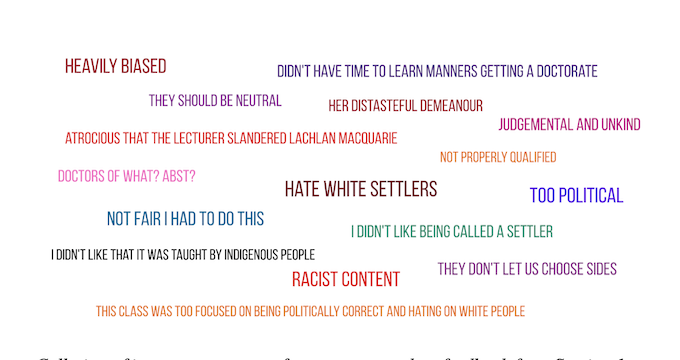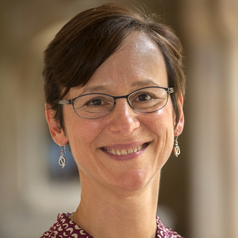Each semester, university staff receive anonymous student evaluations. These surveys are framed as neutral tools to support teaching staff’s ongoing reflection and improvement. On paper, they’re positioned to provide structured and constructive feedback to teaching staff, in a space that is intended to be safe for students (from academic recourse).
But what about the safety of the educators receiving them?
As two Aboriginal women teaching in Critical Indigenous Studies, we know this question too well. The system of anonymous feedback, as it currently stands, can be a site of unfiltered racialised, gendered and deeply personal violence. Yet, because it arrives wrapped in bureaucratic language like “reflection” and “improvement”, it’s too often dismissed as just “part of the job”. But at what cost does this violent ‘part of the job’ come?
Research into the abuse in anonymous feedback surveys has been well documented, with attacks on appearance, particularly amplified for women. These are often received through an impersonal, centralised email, and are often read in isolation.
As Aboriginal women, we know too well the impact of these student surveys. Semester after semester we must brace ourselves for the things we know that will come. Yet it doesn’t matter how much we brace for it, it is always worse than we can imagine.
But the truth is, nothing prepares you for seeing anonymous comments regarding Indigenous peoples, our knowledges, and histories, dragged through a system that was never built for or by us. And the comments post-Referendum? They’re louder, more entitled, more emboldened than ever.
Real comments from anonymous student feedback
These are real comments pulled from anonymous student feedback. We’re told this is about improving teaching practice. As Distinguished Professor Bronwyn Carlson asks “where is the duty of care for us?” as Educators and as people?
Collation of just some extracts of anonymous student feedback from Session 1 2025
Student Feedback or a Strategy of the System?
The intersection of racism, misogyny, and anti-Indigenous sentiment is heightened in these cohorts, particularly when students feel resentment for having to learning Critical Indigenous Studies.
This is even further amplified when the rise of anti-intellectualism is coupled with right wing media which encourages this disdain and devaluation ofIndigenous peoples, knowledges and perspectives.

This is particularly true when students encounter the idea of unpacking their own proximity to settler colonial systems. For some, it is more comfortable to deflect. They do this by attacking the Indigenous tutors teaching the course, and the discipline itself, instead of sitting with the discomfort of learning.
“I don’t like that it was taught by Indigenous people”, “Not properly qualified”, “Her distasteful demeanor” are violent racist, gendered and anti-intellectual critiques of the teacher not the teaching. This is settler fragility manifesting through institutional structures. and they remind us how deeply whiteness is protected, even in the name of education.
Still, We Teach
But there is a flipside of this unfiltered violence. There are pockets of so much joy in receiving feedback about the transformative learning experiences students have had. Perhaps hearing you were their favourite teacher. Or your class challenged them in a good way. Or the constructive and clever feedback, or things you may not expect (for example, students do want in person lectures again!).
But woven through the vitriol are also the words that remind us why we continue to show up.
Words and comments like these:
“I found myself constantly thinking of what I had learnt and how I wanted to change myself and the others around me for the better.”
“At times a confronting unit but I feel that it has changed my world view.”
“This unit should be mandatory for every student, I loved it.”
We remember those students. The ones who sat in their discomfort, who leaned in rather than recoiled. The ones who stayed back after a class to yarn. The ones who later tell us they switched majors, or took our reading list to their family, had hard conversations, or considered the value and complexity of different worldviews.
Those comments are few, but they carry a different kind of weight – one that is relational, and moves across time and space. They remind us that teaching isn’t transactional – it is transformative. And transformative teaching and learning does not just impact the world today, but the futures of tomorrow for all people.
The System Isn’t Broken — It’s Working Perfectly As Designed
As Distinguished Professor Bronwyn Carlson tells us: “It is time for change, real change”.
The system isn’t broken. It’s working exactly as designed; to reinforce whiteness, to privilege student comfort over educator safety, and to silence those of us pushing back against settler colonial norms.
But we’re still here. Still teaching. Still resisting.
We’ve seen the strength of Indigenous students who, for the first time, see themselves reflected in the curriculum — not as deficits, not as histories, but as sovereign peoples.
We’ve watched non-Indigenous students confront their own relations to settler colonial systems. We’ve felt transformational shifts. But this requires tertiary systems that support rather than harm the people doing this work.
Speaking truth to power: where is our safety?
We want duty of care extended to all of us. Not just to students, but also to the Indigenous people, particularly women and gender diverse peoples. We have defied layers of oppression to be standing at the front of the room.
The student feedback system may never love us. But our communities do. Our students, the ones who are genuinely open to learning, do. And we remain committed to showing up, to voicing our truths, and to teaching with our whole selves.
Because our presence in these institutions isn’t just resistance. It’s sovereignty.

Tamika Worrell is from Gamilaroi Country, and has been nurtured by Dharug Ngurra (Country), in Western Sydney. She is a senior lecturer in Critical Indigenous Studies at Macquarie University, researching Indigenous representation in education and Indigenous digital lives, including AI.

Ash Moorehead a Biripi Worimi woman, now living with/on Dunghutti Country. She is an associate lecturer in the Department of Critical Indigenous Studies at Macquarie University and PhD candidate. Her research explores Indigenous sovereignty at the intersection of Indigenous education and research







